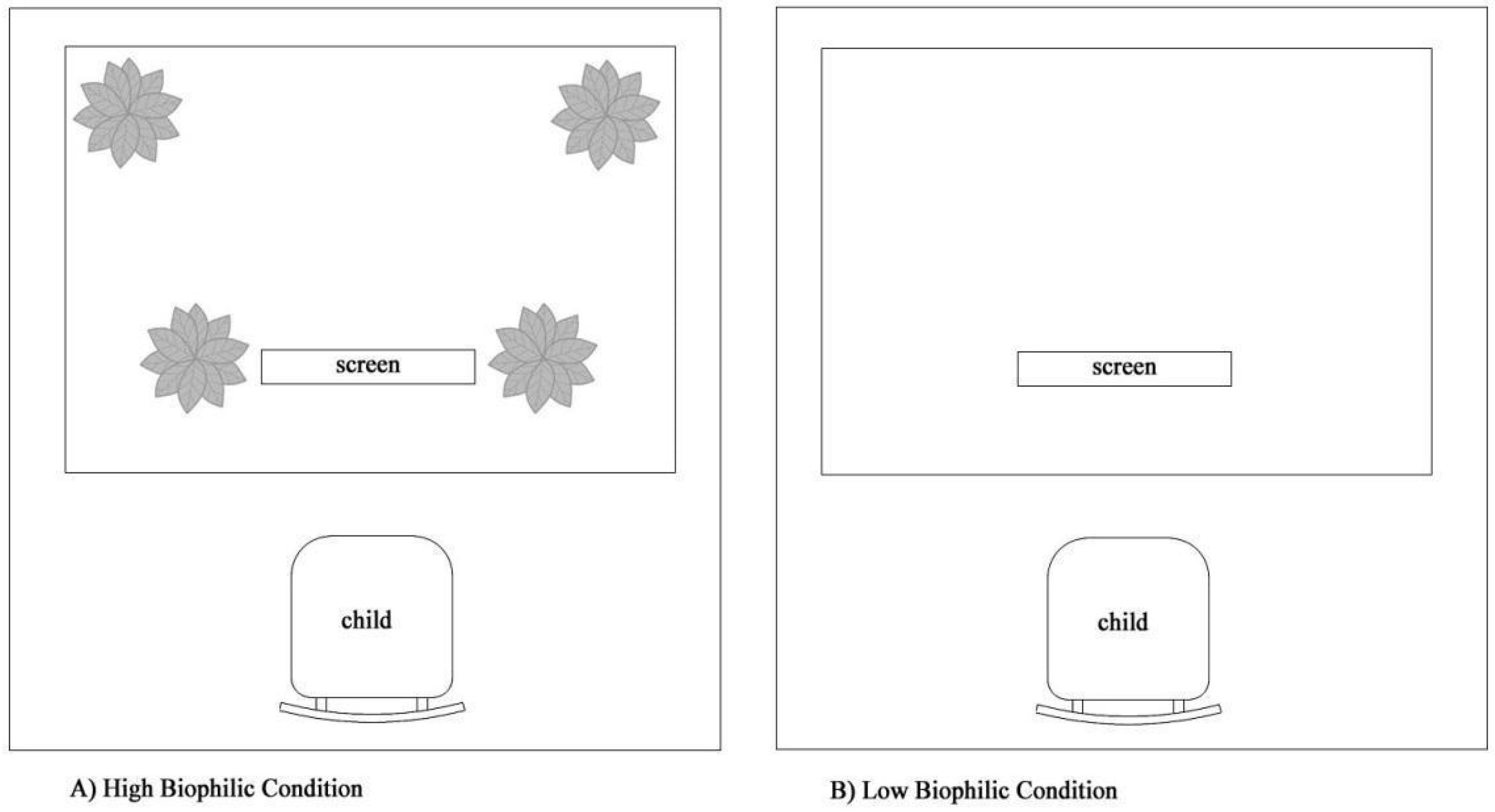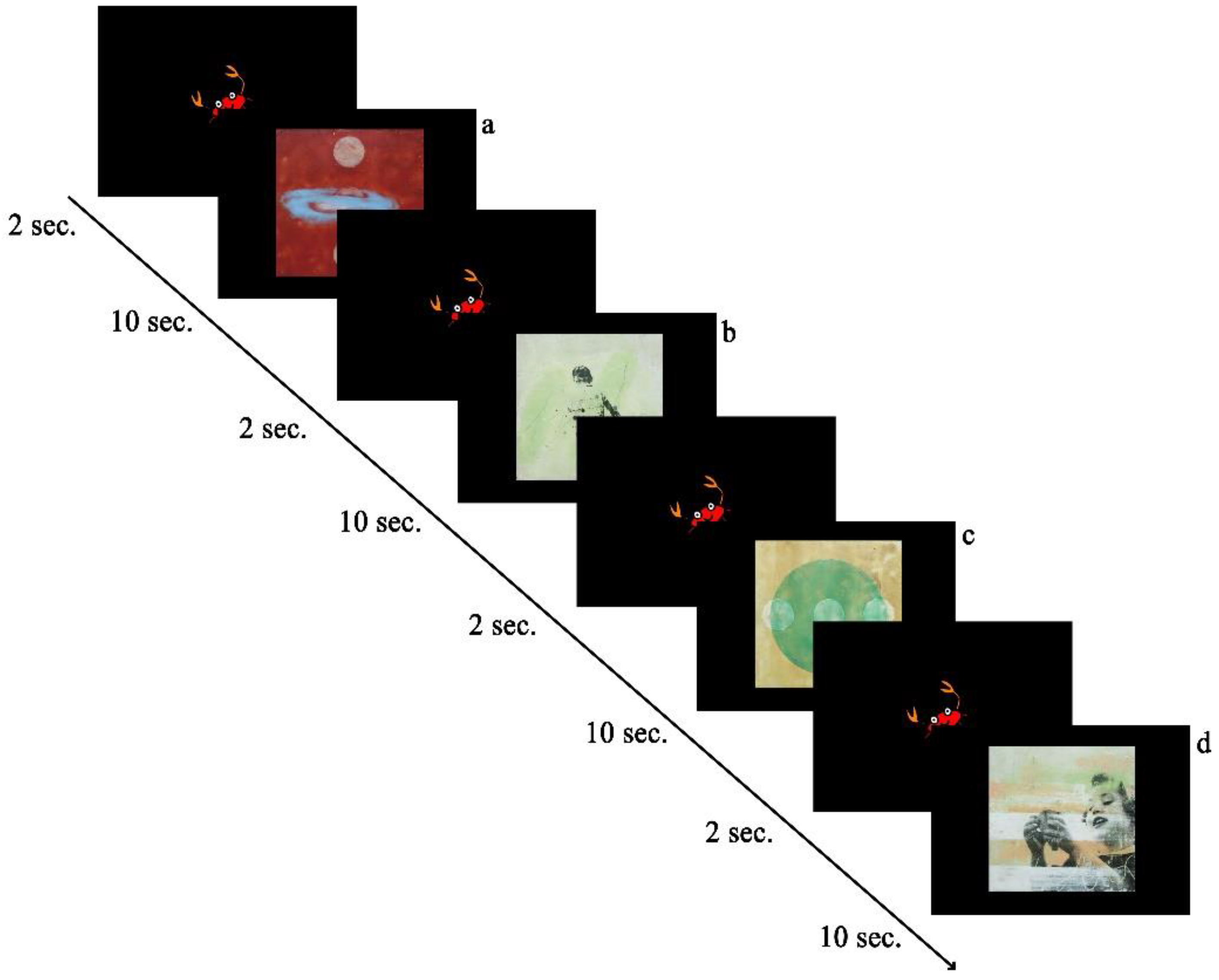Elements of Biophilic Design Increase Visual Attention in Preschoolers
Abstract
1. Introduction
2. Materials and Methods
2.1. Participants
2.2. Setting
2.3. Procedure
2.4. Coding
3. Results
4. Discussion
5. Conclusions
Author Contributions
Funding
Data Availability Statement
Acknowledgments
Conflicts of Interest
References
- Wall, K.; Dockrell, J.; Peacey, N. The importance of the built environment for learning-A research evidence overview. 39th International Congress on Noise Control Engineering 2010. INTER-NOISE 2010, 2, 1016–1025. [Google Scholar]
- Salingaros, N.A.; Masden, K.I. Neuroscience, the natural environment, and building design. In Bringing Buildings to Life Conference; Yale University: New Haven, CT, USA, 2006. [Google Scholar]
- Gillis, K.; Gatersleben, B. A review of psychological literature on the health and well-being benefits of biophilic design. Buildings 2015, 5, 948–963. [Google Scholar] [CrossRef]
- Beatley, T. (Ed.) Handbook of biophilic city planning and design. In Handbook of Biophilic City Planning and Design; Island Press: Washington, DC, USA, 2016. [Google Scholar]
- Zhong, W.; Schröder, T.; Bekkering, J. Biophilic design in architecture and its contributions to health, well-being, and sustainability: A critical review. Front. Archit. Res. 2022, 11, 114–141. [Google Scholar] [CrossRef]
- Browning, W.D.; Ryan, C.O. Nature Inside: A Biophilic Design Guide; Routledge: London, UK, 2020. [Google Scholar]
- Miller, N.; Pogue, D.; Gough, Q.; Davis, S. Green buildings and productivity. J. Sustain. Real Estate 2009, 1, 65–89. [Google Scholar] [CrossRef]
- McGee, B.; Park, N.K. Color, light, and materiality: Biophilic interior design presence in research and practice. Interiority 2022, 5, 27–52. [Google Scholar] [CrossRef]
- Kellert, S.R.; Wilson, E.O. Biophilia. Hum. Ecol. 2008, 462–466. [Google Scholar]
- Dijkstra, K.; Pieterse, M.E.; Pruyn, A. Stress-reducing effects of indoor plants in the built health care environment: The mediating role of perceived attractiveness. Prev. Med. 2008, 47, 279–283. [Google Scholar] [CrossRef]
- McGee, B.; Marshall-Baker, A. Loving nature from the inside out: A biophilia matrix identification strategy for designers. HERD Health Environ. Res. Des. J. 2015, 8, 115–130. [Google Scholar] [CrossRef]
- Marte, E.; Calumpit, A.; de Sá Bessa, B.; Toledo, A.; Fadda, R.; Skoler, T. Testing reliability of biophilic design matrix within urban residential playrooms. Front. Psychol. 2020, 11, 570099. [Google Scholar] [CrossRef]
- Kaplan, S.; Kaplan, R. The visual environment: Public participation in design and planning. J. Soc. Issues 1989, 45, 59–86. [Google Scholar] [CrossRef]
- Kaplan, R.; Kaplan, S. The Experience of Nature: A Psychological Perspective; Cambridge University Press: Cambridge, UK, 1989. [Google Scholar]
- Pinto, Y.; van der Leij, A.R.; Sligte, I.G.; Lamme, V.A.; Scholte, H.S. Bottom-up and top-down attention are independent. J. Vis. 2013, 13, 16. [Google Scholar] [CrossRef]
- Berman, M.G.; Jonides, J.; Kaplan, S. The restorative benefits of interacting with nature: Cognitive and neuroscientific perspectives. Psychol. Sci. 2008, 19, 1207–1212. [Google Scholar] [CrossRef]
- Berto, R. Exposure to restorative environments helps restore attentional capacity. J. Environ. Psychol. 2005, 25, 249–259. [Google Scholar] [CrossRef]
- Raanaas, R.K.; Evensen, K.H.; Rich, D.; Sjøstrøm, G.; Patil, G. Benefits of indoor plants on attention capacity in an office setting. J. Environ. Psychol. 2011, 31, 99–105. [Google Scholar] [CrossRef]
- Lipscomb, M.; Leed, A.B.C.; Rollings, K. Outside in: Influences of Indoor Plants on Psychological Well-Being and Memory Task Performance in a Workplace Setting. Perkins Will Res. J. 2017, 9, 33–43. [Google Scholar]
- Fisher, A.V.; Godwin, K.E.; Seltman, H. Visual Environment, Attention Allocation, and Learning in Young Children: When Too Much of a Good Thing May Be Bad. Psychol. Sci. 2014, 25, 1362–1370. [Google Scholar] [CrossRef]
- Kidd, C.; Piantadosi, S.T.; Aslin, R.N. The Goldilocks Effect: Human Infants Allocate Attention to Visual Sequences That are Neither too simple nor too complex. PLoS ONE 2012, 7, e36399. [Google Scholar] [CrossRef]
- Dadvand, P.; Tischer, C.; Estarlich, M.; Llop, S.; Dalmau-Bueno, A.; López-Vicente, M.; Valentín, A.; de Keijzer, C.; Fernández-Somoano, A.; Lertxundi, N.; et al. Lifelong Residential Exposure to Green Space and Attention: A Population-Based Prospective Study. Environ. Health Perspect. 2017, 125, 9. [Google Scholar] [CrossRef]
- Faber Taylor, A.; Kuo, F.E. Children with attention deficits concentrate better after walk in the park. J. Atten. Disord. 2009, 12, 402–409. [Google Scholar] [CrossRef]
- Amicone, G.; Petruccelli, I.; De Dominicis, S.; Gherardini, A.; Costantino, V.; Perucchini, P.; Bonaiuto, M. Green breaks: The restorative effect of the school environment’s green areas on children’s cognitive performance. Front. Psychol. 2018, 9, 1579. [Google Scholar] [CrossRef]
- Berto, R.; Pasini, M.; Barbiero, G. How does Psychological Restoration Work in Children? An Exploratory Study. J. Child Adolesc. Behav. 2015, 3, 56403985. [Google Scholar] [CrossRef]
- Gunn, C.; Vahdati, M.; Shahrestani, M. Green walls in schools-The potential well-being benefits. Build. Environ. 2022, 224, 109560. [Google Scholar] [CrossRef]
- van den Bogerd, N.; Dijkstra, S.C.; Tanja-Dijkstra, K.; de Boer, M.R.; Seidell, J.C.; Koole, S.L.; Maas, J. Greening the classroom: Three field experiments on the effects of indoor nature on students’ attention, well-being, and perceived environmental quality. Build. Environ. 2020, 171, 106675. [Google Scholar] [CrossRef]
- Lindemann-Matthies, P.; Benkowitz, D.; Hellinger, F. Associations between the naturalness of window and interior classroom views, subjective well-being of primary school children, and their performance in an attention and concentration test. Landsc. Urban Plan. 2021, 214, 104146. [Google Scholar] [CrossRef]
- Barbiero, G.; Berto, R.; Venturella, A.; Maculan, N. Bracing Biophilia: When biophilic design promotes pupil’s attentional performance, perceived restorativeness, and affiliation with Nature. Environ. Dev. Sustain. 2021. [Google Scholar] [CrossRef]
- Kaplan, R. The restorative benefits of nature: Toward an integrative framework. J. Environ. Psychol. 1995, 15, 241e248. [Google Scholar] [CrossRef]
- Cornoldi, C.; Gardinale, M.; Masi, A.; Pettinò, L. Impulsività e Autocontrollo; Edizioni Erickson: Gardolo, Italy, 1996. [Google Scholar]
- Determan, J.; Akers, M.A.; Albright, T.; Browning, B.; Martin-Dunlop, C.; Archibald, P.; Caruolo, V. The Impact of Biophilic Learning Spaces on Student Success. American Institute of Architecture, Building Research Knowledgebase. 2019. Available online: https://www.hcm2.com/wp-content/uploads/AIA-Biophilic-Design-Research_The-Impact-of-Biophilic-Learning-Spaces-on-Student-Success.pdf (accessed on 1 January 2023).
- Scheiter, K.; Van Gog, T. Using eye tracking in applied research to study and stimulate the processing of information from multi-representational sources. Appl. Cogn. Psychol. 2009, 23, 1209–1214. [Google Scholar] [CrossRef]
- Krentz, U.C.; Earl, R.K. The baby as beholder: Adults and infants have common preferences for original art. Psychol. Aesthet. Creat. Arts 2013, 7, 181. [Google Scholar] [CrossRef]
- Cook, J.; Barbalat, G.; Blakemore, S.J. Top-down modulation of the perception of other people in schizophrenia and autism. Front. Hum. Neurosci. 2012, 6, 175. [Google Scholar] [CrossRef]
- Itti, L.; Koch, C. Computational modeling of visual attention. Nat. Rev. Neurosci. 2001, 2, 194–203. [Google Scholar] [CrossRef]
- Altomonte, S.; Allen, J.; Bluyssen, P.M.; Brager, G.; Heschong, L.; Loder, A.; Schiavon, S.; Veitch, J.A.; Wang, L.; Wargocki, P. Ten questions concerning well-being in the built environment. Build. Environ. 2020, 180, 106949. [Google Scholar] [CrossRef]
- Striano, T.; Stahl, D. Sensitivity to triadic attention in early infancy. Dev. Sci. 2005, 8, 333–343. [Google Scholar] [CrossRef] [PubMed]
- Liberati, A.; Fadda, R.; Doneddu, G.; Congiu, S.; Javarone, M.; Striano, T.; Chessa, A. A Statistical Physics Perspective to Understand Social Visual Attention in Autism Spectrum Disorder. Perception 2017, 46, 889–913. [Google Scholar] [CrossRef] [PubMed]
- Glaholt, M.G.; Reingold, E.M. Direct control of fixation times in scene viewing: Evidence from analysis of the distribution of first fixation duration. Vis. Cogn. 2012, 20, 605–626. [Google Scholar] [CrossRef]
- Castelhano, M.S.; Henderson, J.M. Incidental visual memory for objects in scenes. Vis. Cogn. 2005, 12, 10171040. [Google Scholar] [CrossRef]
- Henderson, J.M.; Hollingworth, A. Eye movements and visual memory: Detecting changes to saccade targets in scenes. Percept. Psychophys. 2003, 65, 5871. [Google Scholar] [CrossRef]
- Hollingworth, A. Constructing visual representations of natural scenes: The roles of short- and long-term visual memory. J. Exp. Psychol. Hum. Percept. Perform. 2004, 30, 519537. [Google Scholar] [CrossRef]
- Available online: https://www.tandfonline.com/doi/full/10.1080/23748834.2020.1795405 (accessed on 1 January 2023).
- Wertz, A.E.; Wynn, K. Selective social learning of plant edibility in 6-and 18-month-old infants. Psychol. Sci. 2014, 25, 874–882. [Google Scholar] [CrossRef]
- Mollazadeh, M.; Zhu, Y. Application of Virtual Environments for Biophilic Design: A Critical Review. Buildings 2021, 11, 148. [Google Scholar] [CrossRef]
- Söderlund, J. The Emergence of Biophilic Design; Springer: Cham, Germany, 2019. [Google Scholar]
- Berto, R. The role of nature in coping with psycho-physiological stress: A literature review on restorativeness. Behav. Sci. 2014, 4, 394–409. [Google Scholar] [CrossRef]
- Berto, R.; Barbiero, G.; Barbiero, P.; Senes, G. An individual’s connection to nature can affect perceived restorativeness of natural environments. Some Obs. About Biophilia. Behav. Sci. 2018, 8, 34. [Google Scholar]



| Conditions | N | Mean | SD | |
|---|---|---|---|---|
| Time to First Fixation (seconds) | High-biophilic-design | 15 | 0.031 | 0.072 |
| Low-biophilic-design | 14 | 0.066 | 0.10 | |
| Fixation Count (frequencies) | High-biophilic-design | 15 | 17.28 | 3.30 |
| Low-biophilic-design | 14 | 17.57 | 2.74 | |
| Total Looking Time (seconds) | High-biophilic-design | 15 | 8.99 | 0.91 |
| Low-biophilic-design | 14 | 8.24 | 1.3 |
Disclaimer/Publisher’s Note: The statements, opinions and data contained in all publications are solely those of the individual author(s) and contributor(s) and not of MDPI and/or the editor(s). MDPI and/or the editor(s) disclaim responsibility for any injury to people or property resulting from any ideas, methods, instructions or products referred to in the content. |
© 2023 by the authors. Licensee MDPI, Basel, Switzerland. This article is an open access article distributed under the terms and conditions of the Creative Commons Attribution (CC BY) license (https://creativecommons.org/licenses/by/4.0/).
Share and Cite
Fadda, R.; Congiu, S.; Roeyers, H.; Skoler, T. Elements of Biophilic Design Increase Visual Attention in Preschoolers. Buildings 2023, 13, 1160. https://doi.org/10.3390/buildings13051160
Fadda R, Congiu S, Roeyers H, Skoler T. Elements of Biophilic Design Increase Visual Attention in Preschoolers. Buildings. 2023; 13(5):1160. https://doi.org/10.3390/buildings13051160
Chicago/Turabian StyleFadda, Roberta, Sara Congiu, Herbert Roeyers, and Tricia Skoler. 2023. "Elements of Biophilic Design Increase Visual Attention in Preschoolers" Buildings 13, no. 5: 1160. https://doi.org/10.3390/buildings13051160
APA StyleFadda, R., Congiu, S., Roeyers, H., & Skoler, T. (2023). Elements of Biophilic Design Increase Visual Attention in Preschoolers. Buildings, 13(5), 1160. https://doi.org/10.3390/buildings13051160








